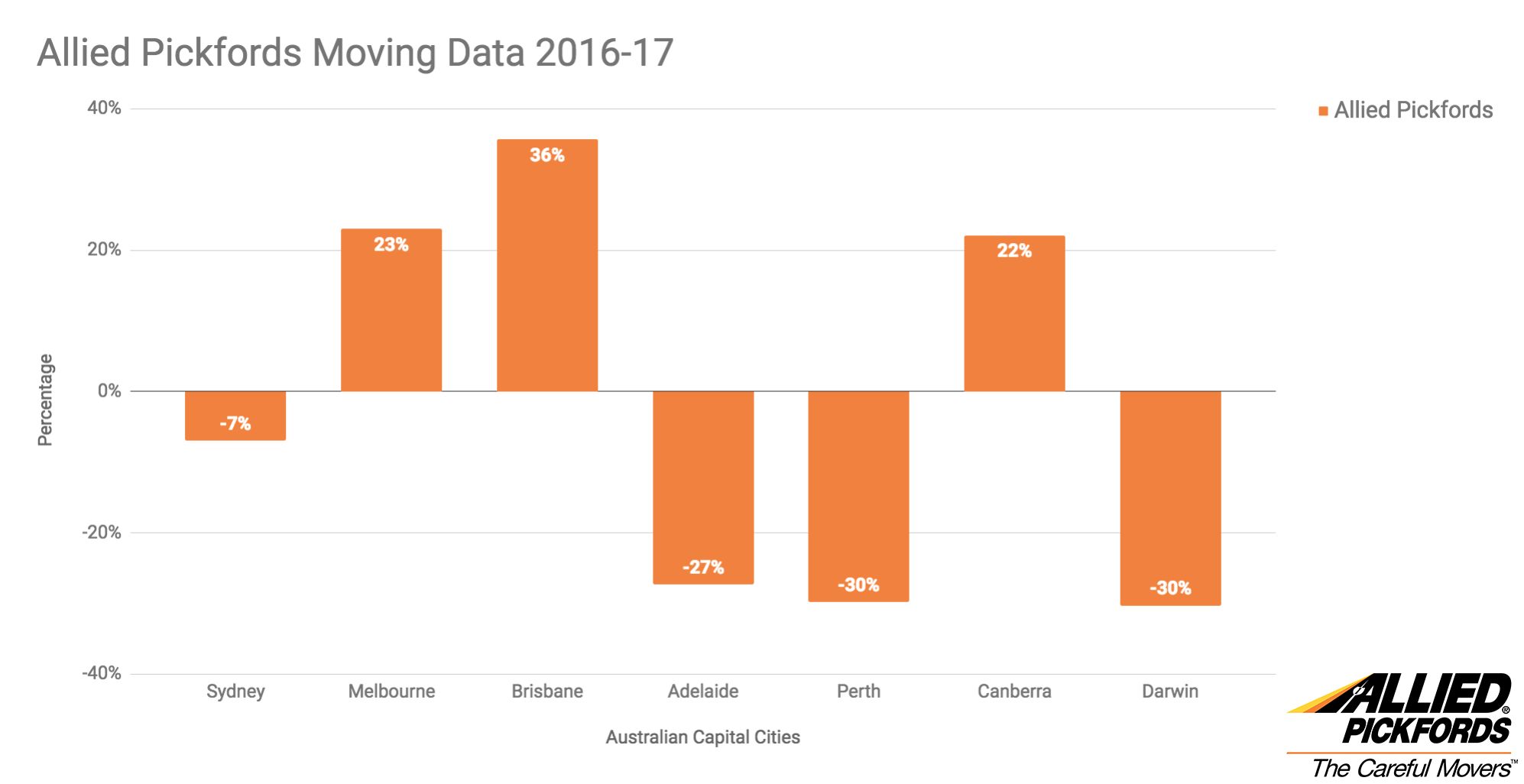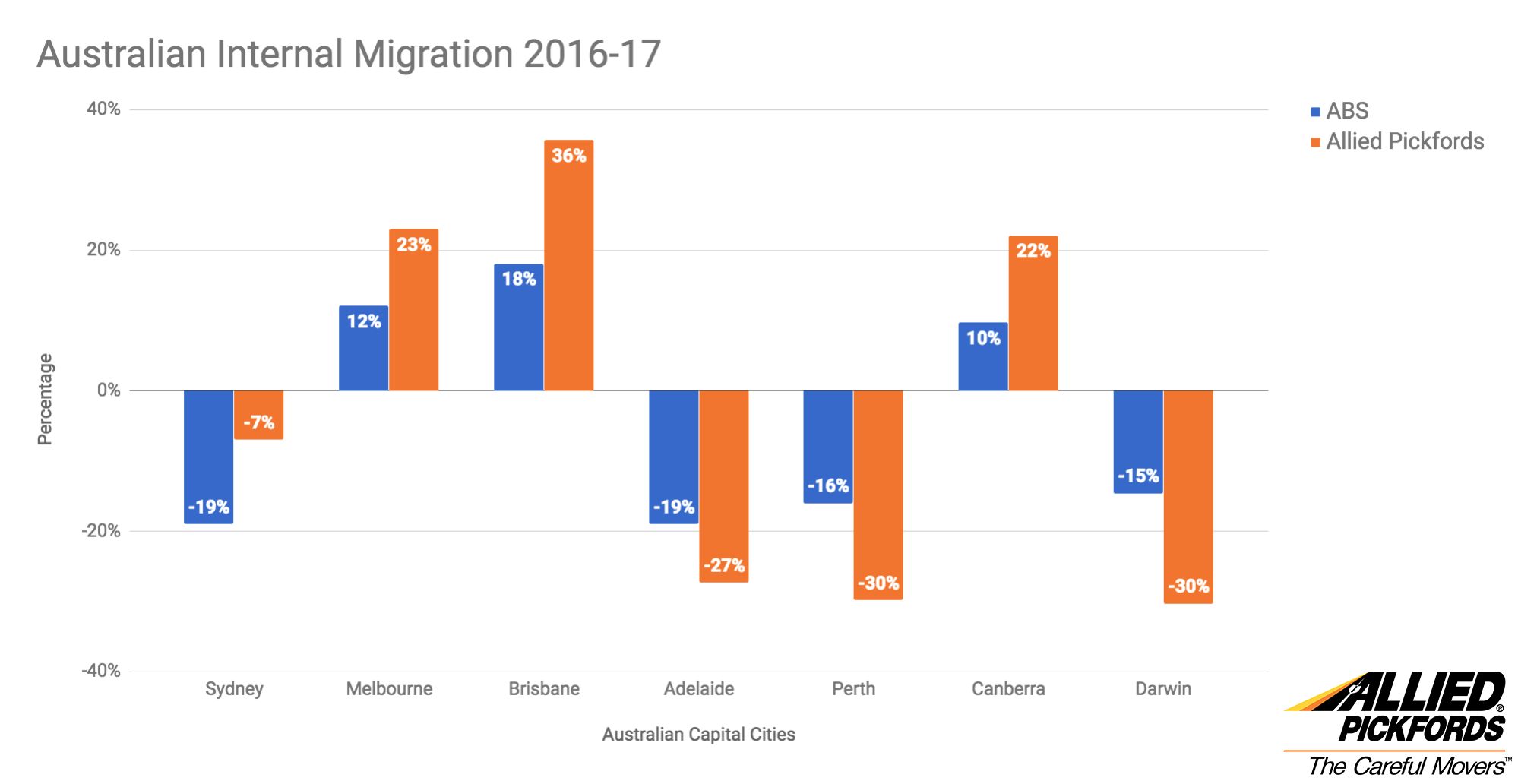Internal migration data looks at the movement of people from one city within Australia to another city within Australia. This data has allowed Allied to identify trends in mobility around the country and to better prepare for the mobility requirements of Australians in the coming year.
Moving Data for the 2016-17 period
Here is what the spread looks like for Allied across each Australian Capital City for 2016-17:
With new data being released by the Australian Bureau of Statistics (ABS) in May 2018, Allied have been able to gain new insights into trends surrounding internal migration and population growth in Australia’s capital cities. Internal migration is a key indicator of population growth statistics in urban areas and helps authorities identify trends in the population change around Australia.
Internal migration recorded in the ABS data noted higher levels of local moves and displayed a decline in interstate or intercity moves. This has been related to declining levels of home ownership due to high property prices.
Low levels of home ownership can be related to a more highly mobile population as people who are renting are more likely to move homes more regularly.
Internal migration data released by the ABS was compared with our own data, and displayed similar trends with respect to internal migration.
Allied data was obtained by measuring household moves conducted between capital cities and does not consider the number of people who are part of that household.
ABS internal migration data looks at individual people as they move homes. Here’s what the comparison among the ABS and Allied data looks like:

Allied identified Hobart and Brisbane as having the highest levels of internal migration for the 2016-17 period which was supported by reports from the ABS. Macquarie bank researchers suggest that increased levels of migration toward Brisbane are associated with increased housing affordability and employment opportunity.
Why are people moving away from Sydney?
Data regarding the population growth of Sydney released by the ABS earlier this year showed that Sydney experienced a 2% population increase, leading to a population of 5.1 million in Australia’s largest city.However, while this data would indicate that Sydney is expanding rapidly, a closer look reveals a growing trend in local Australians moving out of the city. With a 19% decrease in internal migration to Sydney recorded in the 2016-17 period. This statistic was reflected in Allied research on the same year with low levels of moves into Sydney being recorded. Allied data measured the number of households that left Sydney whilst ABS is a reflection of individual people.
Sydney was recorded as having the highest population loss when compared to all other Australian cities amongst all age groups except for ages 15-24. Key factors influencing this trend are high levels of young people moving into the city for education and employment requirements as they begin to exit family homes.
Research group McCrindle conducted a study into why Sydney has experienced such a drop in internal migration, with results showing that Australians are being pushed out of Sydney by cost of living, high housing prices, high traffic and commute times and low opportunity for employment. High cost of real estate is a key decider amongst Australians looking to buy with the average Sydney property costing as much as 13 times the average full-time wage in Australia. (McCringle, 2018).
In an article published by the Sydney Morning Herald earlier this year, it was suggested that an average of 129 people leave Sydney every day for elsewhere in Australia. This is contrasted by an average of 85 people who are estimated to arrive in Sydney. (Hanna, C 2018).
Research by Macquarie Bank suggests that Sydneysiders are beginning to look north to relocate, and interstate migration between NSW and Queensland is at an all-time high. This is reflected in high levels of internal migration toward Brisbane recorded in both ABS and Allied data, with Brisbane being amongst the most popular destinations for Australians looking to relocate interstate.
What other trends does this data provide us with?
ABS and Allied data both indicated high levels of mobility surrounding Hobart, with Hobart being amongst the most popular destinations for internal migration in both reports. This is reflective of a growing economy and housing affordability in Tasmania. Tasmania has been previously referred to as a ‘big improver’ by CommSec reports and it is expected that this trend of Australians looking to Hobart will continue in the coming years.Adelaide experienced its lowest growth rate since 2003-04 with a decline in internal migration similar to that of Sydney. These findings were consistent in both Allied research and ABS data showing a decline in population growth for the capital of South Australia.
ABS and Allied data both recorded a solid decline in internal migration toward Perth. This can be attributed to the end of the mining boom, where mining organisations are seen to be transferring their employees to other locations around Australia.
ABS data and Allied research both recorded moderate to high levels of internal migration toward Melbourne. Melbourne has become an increasingly popular destination and has earnt itself the title of Australia’s fastest growing city after a 2.4% population increase following the 2015–16 period. Melbourne’s population is expected to continue to grow over the coming years with high levels of mobility predicted for Melbourne and surrounding areas.
Allied data was well supported by findings of the 2016-17 Census with similar trends relating to internal migration being seen across the country.
The Allied team welcome the sharing of this data by linking back to this article as attribution.
References
Australian Bureau of Statistics 2018, Population Shift: Understanding internal migration in Australia, no. 2071.0, ABS, viewed 2/07/2018, <https://goo.gl/BqfX4c>Australian Bureau of Statistics 2017, Regional Population Growth, 2015-16, no. 3218.0, ABS, viewed 2/07/2018, <https://goo.gl/XR9k5T>
Australian Bureau of Statistics 2018, Regional Population Growth, Australia 2016-17, no. 3218.0, ABS, viewed 2/07/2018 <https://goo.gl/8nmT8k>
Australian Bureau of Statistics 2018, Regional Population Growth, 2016-17, no. 3218.0, ABS, viewed 2/07/2018 <http://www.abs.gov.au/ausstats/abs@.nsf/mf/3218.0>
Burgess, G 2017, ‘Hobarts booming’ say young business people as they move to the island state for its affordability’, ABC News, 23 January 2017, viewed 2 July 2018, <http://www.abc.net.au/news/2017-01-23/tasmania-improves-economic-standing-in-state-of-states-report/8202344>
Chung, F 2018, ‘Sydney’s population grows by 100,000 for the first time as locals leave to make way for immigrants’, News.com, 25 April 2018, viewed 2 July 2018 <https://goo.gl/tTDMY3>
Fell, A 2018, ‘The Future of Sydney Report’, McCridle Insights, viewed 2 July 2018, <https://mccrindle.com.au/insights/blog/future-sydney-report/>
Hanna, C 2018, ‘ The world loves Sydney. Australians aren’t that fussed’ The Sydney Morning Herald, 25 February 2018, viewed 2 July 2018, <https://www.smh.com.au/interactive/2018/the-world-loves-sydney-australians-arent-that-fussed/>
Janda, M 2017, ‘State of the States: NSW maintains economic leqad, Tasmania improves, WA lags’, ABC News, 23 January 2017, viewed 2 July 2018,<http://www.abc.net.au/news/2017-01-23/state-of-the-states-nsw-maintains-economic-lead/8202536>
Letts, S 2017, ‘Soaring Sydney house prices to spark mass migration north: Macquarie’, ABC News, 6 October 2017, viewed 2 July 2018 <http://www.abc.net.au/news/2017-10-06/soaring-sydney-house-prices-to-spark-mass-migration-north/9022126>
Miller, B 2018, ‘Melbourne, Sydney and Brisbane populations soar but growth drivers differ’, ABC News, 25 April 2018, viewed 2 July 2018, <http://www.abc.net.au/news/2018-04-24/melbourne-sydney-brisbane-populations-soar-growth-drivers-differ/9693470>
